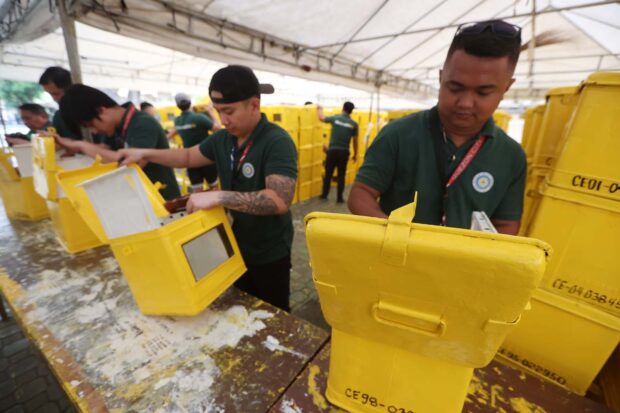
City Treasurer’s Office (CTO) workers rush the cleaning of ballot boxes for the barangay and Sangguniang Kabataan Elections at the Quezon City Hall compound in Quezon City on Tuesday, Oct. 17, 2023. (Photo by NIÑO JESUS ORBETA / Philippine Daily Inquirer)
MANILA, Philippines — After a six-week wait for the candidates, the official campaign period for the Oct. 30 barangay and Sangguniang Kabataan (SK) elections starts today.
Aspirants for positions in the country’s smallest political units may finally go on the stump, but under certain restrictions, from Oct. 19 to 28.
Following the period for the filing of certificates of candidacy from Aug. 28 to Sept. 4, the Commission on Elections (Comelec) has so far filed disqualification petitions against 137 candidates for premature campaigning.
The poll body has dismissed complaints against 723 candidates for lack of basis, while ordering nearly 6,000 candidates to explain why they should not be charged.
The Comelec deputy executive director for operations, Rafael Olano, reminded election officers to strictly enforce the campaign rules.
Olano warned that candidates would still be held accountable for oversized campaign posters even if the materials were put up on private property.
READ: Comelec to BSKE candidates: Follow 5-peso per voter expense rule
‘Operation Baklas’
Election rules limit the size of campaign posters, billboards and tarpaulins to a maximum dimension of 2 x 3 feet.
Even if the materials are meant to be put together to form a collage-like poster, their maximum size should still not exceed 2 x 3 feet, according to Olano.
Campaign materials could only be put up in public places that are designated as common poster areas.
Posters without the phrase “political advertisement paid for/by” or “printed free of charge” are considered illegal and can be removed by Comelec personnel.
READ: Comelec places 242 barangays under ‘red category’ for 2023 BSKE
No handouts
“In case there are unlawful campaign materials posted on public and private properties, the election officer shall send a notice to remove and a show-cause order to the concerned candidates” to explain why they should not be charged with election offense, said Olano in an Oct. 16 memo.
Comelec would undertake a nationwide “Operation Baklas” to dismantle illegal campaign materials in public places on Oct. 20 and 27, he added.
The rules also ban the handout of food and drinks during and after a campaign sortie or meeting, as well as usual giveaways like shirts, ballers, bags, sun visors, hats or caps, umbrellas, handkerchiefs, ballpens, fans, candies and other “items of value.” “The candidate and five of his/her campaign staff may wear T-shirts with the candidate’s picture during the campaign period,” said Olano.
Comelec has also prohibited the distribution of cash or in-kind assistance through the government “assistance to individuals in crisis situation” program from Oct. 20 to Oct. 30.
However, it would allow the distribution of aid “which are normally given to qualified individuals” including food, transportation, medical, educational, burial and other similar assistance,” said Olano.
By the numbers
Based on latest Comelec data, 67,839,851 registered voters who are at least 18 years old may vote in the barangay elections, while 23,254,958 registered voters who are 15 to 30 years old may vote in the SK elections.
This means 21,420,550 registered voters who are 18 to 30 years old may vote both in the barangay and SK elections.
Meanwhile, 1,834,408 registered voters who are 15 to 17 years old may vote only in the SK elections.
The country has 42,001 barangays, which serve as its smallest political unit.
Each barangay will elect one barangay captain and seven members of the barangay council, and one SK chairperson and seven SK council members.
Police as BEIs
Meanwhile, more than 4,000 police officers are ready to serve as members of board of election inspectors (BEIs) in the Oct. 30 elections, according to the chief of the Philippine National Police.
Gen. Benjamin Acorda Jr. said 4,429 officers based in the Bangsamoro Autonomous Region in Muslim Mindanao (BARMM), Northern Mindanao, Calabarzon and Bicol regions are on standby as substitute for BEIs—usually public school teachers—who may not be able to do poll duty for security concerns.
“Not that these areas are perennial election flash points, but some of the parameters for the classification of election areas are present in these localities, such as the presence of threat groups, historical data of election-related incidents and intense political rivalry; and presence of organized crime and partisan armed groups,” Acorda said in a press briefing in Camp Crame on Monday.Red, Orange, Yellow
Among the country’s 42,001 barangays, 356 are under the highest “Red” category for being “areas of grave concern,” according to Acorda. The PNP earlier said 70 percent of these were in BARMM.
Red areas—which have a history of election-related incidents—are placed under Comelec supervision.
Meanwhile, 1,325 barangays were classified as Orange (for being areas of immediate concern with serious armed threat), while 1,196 villages were categorized as Yellow (with election-related incidents in the last voting and previously under Comelec control).
On Wednesday, PNP spokesperson Col. Jean Fajardo said that out of the 88 recorded violent incidents since the start of the election period on Aug. 28, 18 were validated as election-related incidents (ERIs). They happened in BARMM (4), Calabarzon (3), Eastern Visayas (3), Northern Mindanao (3), Bicol Region (2), Ilocos Region (1), Central Visayas (1), and Zamboanga Peninsula (1).
The figures have exceeded the record from the last barangay elections, held in 2018, where there were 57 violent incidents, with only seven later verified to be ERIs.